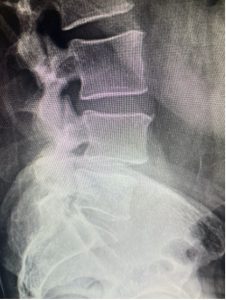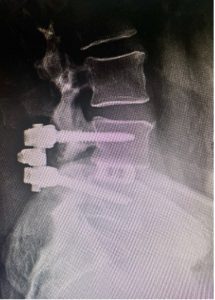Here is a recent case that shows why spinal fusion is often needed along with laminectomy (decompression) surgery. It also illustrates the importance of having a thorough evaluation done by your doctor. What makes a thorough evaluation is having a complete history and proper X-rays.
Transforaminal Lumbar Interbody Fusion (TLIF) Spinal Fusion Case Study
This patient had spinal stenosis at L4-5 on MRI that looks straightforward as the first image shows.

First, here’s a little background on the lumbar spine. The L4 and L5 are the two lowest vertebrae of the lumbar spine, which is part of the lower back. The lower back has five lumbar vertebrae. Between each one is a spongy cushion known as a lumbar disc.
This contains a soft, jellylike center known as the nucleus pulposus. Surrounding the center is a layer of hardy cartilage called the disc annulus. The discs act as shock absorbers. The bottom part of the lower back carries the most weight.
However, the patient said his back pain got worse when he stood up. So, the doctor ordered standing X-rays as the second image shows.

The X-rays revealed that he had severe spinal stenosis as the L4 and L5 as well as spondylolisthesis, which caused instability. Spinal stenosis is when the space within the spine becomes narrow. Because of this, the spine puts pressure on the nerves causing them to become pinched, compressed, or irritated. Hence, when he stood up, he felt the pain from the nerve being pinched or compressed.
Spondylolisthesis, on the other hand, is when one of the vertebrae slips out of place. So, the patient has two things going on: the space between the bones is thin and a slipped disc.
Outcome of TLIF Spinal Fusion
Based on this new information and the patient’s history, the ideal treatment is to do a wide decompression along with instrumentation and fusion. The next image is the postoperative X-ray taken six weeks after the L4 and L5 laminectomy and Transforaminal Lumbar Interbody Fusion (TLIF) back surgery.

In doing the TLIF spinal fusion, the surgeon stabilized the spinal vertebra. It prevents movement between the bones of the connecting vertebra. Spinal fusion with instrumentation involves using implants such as cages, rods, hooks, and screens to fuse the vertebrae together.
The result? It resolved all of the patient’s symptoms including his back pain and leg pain.
Have a question? Please contact us or call 214-823-2052. We have two conveniently located offices in Addison and Dallas serving patients in Dallas, Addison, Plano, Frisco, Garland, and other cities in the DFW metroplex.







